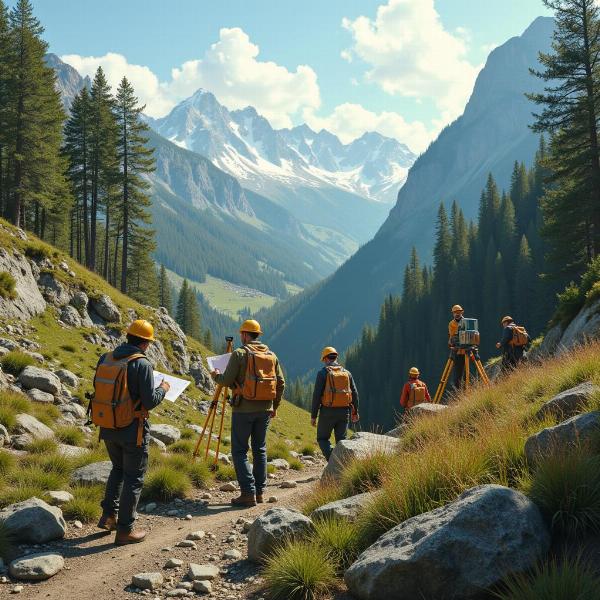Understanding the meaning of “ravine” in Hindi is crucial for anyone navigating Indian landscapes, literature, and cultural contexts. The word encapsulates a specific geographical feature and carries with it a rich tapestry of associations. This article delves into the various Hindi translations of “ravine,” exploring their nuances and providing practical examples to solidify your comprehension.
Exploring the Hindi Equivalents of “Ravine”
The most common Hindi translation for “ravine” is नाला (nālā). This word accurately depicts a narrow, steep-sided valley carved by running water, often dry except during the rainy season. Think of the rugged terrain found in the Chambal region, where deep nālās crisscross the landscape. Another suitable term is खड्ड (khaḍḍ), which signifies a ditch, pit, or gully, often smaller than a nālā. This word is commonly used in everyday conversation.
Regional Variations and Contextual Usage
Depending on the specific region of India, other words might also be used to describe a ravine. For instance, गर्ज (garj), while primarily meaning “roar,” can also refer to a deep gorge or chasm, especially in poetic or literary contexts. The word भीर (bhīr) describes a precipice or steep cliff, often associated with ravines. Understanding these regional variations is key to accurate communication.
Ravines in Indian Literature and Culture
Ravines hold a special significance in Indian literature and folklore, often depicted as places of mystery and danger. They are sometimes associated with bandits or supernatural beings, adding a layer of intrigue to their physical presence. Conversely, they can also symbolize resilience and the power of nature.
The Importance of Accurate Translation
Accurate translation of “ravine” is crucial in various fields, from geographical surveys and environmental studies to literary translations and cultural interpretations. Using the correct Hindi term ensures clear communication and avoids misinterpretations.
 Importance of Accurate Ravine Translation
Importance of Accurate Ravine Translation
Ravines and Their Environmental Impact
Ravines can play a significant role in soil erosion and water management. Understanding their formation and characteristics is crucial for developing effective strategies for land conservation and sustainable development. This necessitates the accurate use of terminology in related discussions and research.
What is the difference between a ravine and a valley?
While both ravines and valleys are depressions in the earth’s surface, ravines are typically smaller and steeper than valleys. Ravines are characterized by their narrow, V-shaped profiles created by erosion, whereas valleys can be wider and have more gentle slopes.
Are ravines dangerous?
Ravines can be dangerous due to their steep slopes and unstable terrain. They can be prone to landslides, flash floods, and rockfalls, particularly during the monsoon season. It is important to exercise caution when navigating these areas.
Why are ravines important for biodiversity?
Despite the potential dangers, ravines can provide unique habitats for a variety of plant and animal species. The varied microclimates and diverse terrain within a ravine can support a wide range of biodiversity, often different from the surrounding landscape.
Conclusion: Mastering the Meaning of Ravine in Hindi
This exploration of “ravine meaning in hindi” has provided a comprehensive understanding of the various Hindi terms used, their nuances, and their cultural significance. From nālā to khaḍḍ and the more poetic garj, grasping these terms enriches your understanding of the Indian landscape, language, and cultural narratives. Accurately using these terms is crucial for effective communication and demonstrates a deeper appreciation for the complexities of the Hindi language.
FAQ:
- What is the most common Hindi word for ravine? Nālā (नाला) is the most common and widely understood Hindi word for ravine.
- What are some other Hindi words that can describe a ravine? Other terms include khaḍḍ (खड्ड), garj (गर्ज), and bhīr (भीर), each with its own specific connotations.
- Why is it important to know the different Hindi words for ravine? Using the correct term ensures accurate communication and reflects an understanding of regional variations and cultural context.
- Where can I find more information about ravines in India? Geographical surveys, environmental studies, and literary works often provide detailed information about ravines in India.
- How can I contribute to the preservation of ravines in India? Supporting organizations focused on land conservation and sustainable development can contribute to the preservation of these unique landscapes.
Meaning-Hindi.in specializes in accurate and culturally sensitive Hindi translation services. We offer a wide range of services, including business and legal document translation, technical translation, website localization, and more. Our team of expert linguists ensures that your message is conveyed clearly and effectively in Hindi and other languages. Contact us today at [email protected] or +91 11-4502-7584 for all your Hindi translation needs. Meaning-Hindi.in is your trusted partner for bridging language barriers and fostering effective communication.